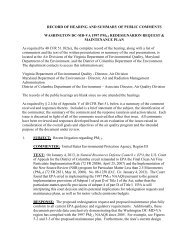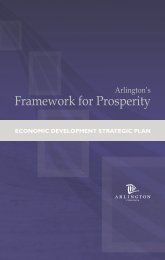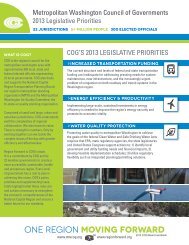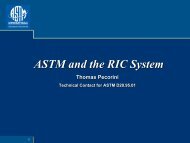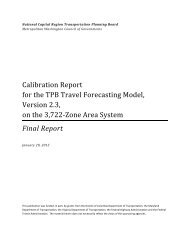PTI Local Government Energy Assurance Guidelines - Metropolitan ...
PTI Local Government Energy Assurance Guidelines - Metropolitan ...
PTI Local Government Energy Assurance Guidelines - Metropolitan ...
You also want an ePaper? Increase the reach of your titles
YUMPU automatically turns print PDFs into web optimized ePapers that Google loves.
Type of Asset a Example a Typical Criteria that Can Be Applied to<br />
Determine Criticality b<br />
Senior Senior citizen centers, retirement communities Facilities requiring a State license to operate<br />
Social Service Homeless/transient shelters, missions and<br />
soup kitchens, youth, family, and battered<br />
Facilities that require regular municipal fire<br />
safety inspections<br />
person shelters, heating and cooling shelters<br />
Detention<br />
Centers<br />
Jails, youth detention centers<br />
All facilities<br />
Community<br />
Centers<br />
Public Assembly<br />
Libraries, civic centers, recreational facilities<br />
Sports stadiums, concert auditoriums, theaters,<br />
cinemas, religious facilities, shopping malls,<br />
conference centers, museums, art centers<br />
Facilities that require regular municipal fire<br />
safety inspections<br />
Facilities that require regular municipal fire<br />
safety inspections<br />
Hotels Hotels, motels, boarding houses Facilities required to register under tax laws<br />
High-rise<br />
Apartments, condos, office buildings<br />
Buildings seven stories or higher<br />
Buildings<br />
Food Service Restaurants, grocery stores, supermarkets,<br />
food processing facilities<br />
Facilities required to register under tax laws,<br />
facilities with significant food quantities stored<br />
on the premises<br />
Industry Hazardous material handling All facilities<br />
Notes:<br />
a. The types of assets and examples are illustrative rather than comprehensive.<br />
b. These specific criteria are illustrative. There is no universal agreement on the numbers or types of assets shown here. <strong>Local</strong><br />
governments must adjust these criteria to meet local needs.<br />
It is important to inventory key assets and any others that may be important to maintaining essential services that<br />
the local jurisdiction is responsible for, even if the local government does not own or operate them (as in the case<br />
of electricity generating power plants that may be miles away from the jurisdiction’s geographic border). The same<br />
should be done for any/all other non-city assets, such as regional hospitals, State/Federal government buildings,<br />
large commercial buildings, and industrial facilities. As part of the inventory, identify the entity having primary<br />
responsibility for providing energy to each asset, and the type of energy provided. Determine and log who has<br />
primacy for the entity—whether it is the local government or a different entity. This information is some of the most<br />
valuable that can be collected as part of the EAP.<br />
Mapping out key assets in a user-friendly graphic, as shown in Figure 6 (developed by the National Oceanic and<br />
Atmospheric Administration [NOAA] as part of its “community assessment tool”), is another effective element to<br />
consider during EAP development.<br />
58 | 3 – How to Develop or Enhance a <strong>Local</strong> <strong>Energy</strong> <strong>Assurance</strong> Plan



